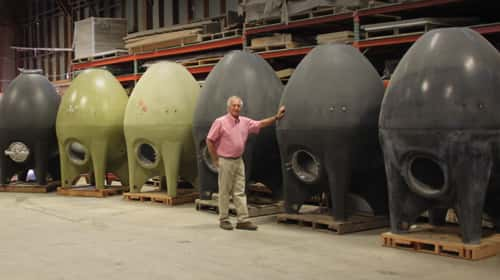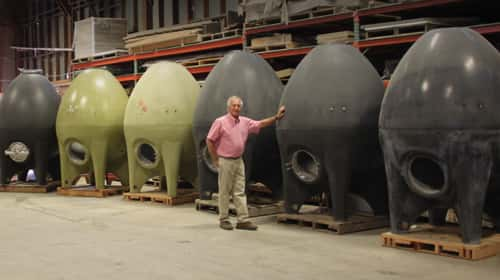 “Sooner or later, everything old is new again,” famed author Stephen King once wrote. He wasn’t referring to concrete tanks for fermenting and storing premium wine, but nonetheless, in countless wineries throughout the North Bay, what was old is now new. Concrete tanks are back in a big way, and a local company that fabricates these unique vessels can’t keep up with the demand.
“Sooner or later, everything old is new again,” famed author Stephen King once wrote. He wasn’t referring to concrete tanks for fermenting and storing premium wine, but nonetheless, in countless wineries throughout the North Bay, what was old is now new. Concrete tanks are back in a big way, and a local company that fabricates these unique vessels can’t keep up with the demand.
Sonoma Cast Stone in Petaluma has been making concrete fermentation tanks for eight years. Owner Steve Rosenblatt started his company 20 years ago to create concrete for custom walls, countertops and sinks––what he refers to now as the “architectural” side of his business. Then one day his neighbor, award-winning winemaker Don Van Staaveren, approached him with a proposal.
“Don showed me a photo of a French-made concrete wine tank and asked, ‘You do stuff with concrete––can you do this?’” recalls Rosenblatt. “I told him we could, but why would we? He said, ‘Because it’s the hottest thing in winemaking out there right now.’”
Van Staaveren arranged for Rosenblatt to have a business lunch with several winemakers who had experience using concrete tanks. “From that meeting, I did exactly what those winemakers recommended and developed a tank that’s far superior to anything else out there,” he says. “Others are made with what I call ‘sidewalk’ concrete, but ours are a more sophisticated composite fiber concrete for strength, with centuries-proven conventional concrete portion that touches the wine.”
Sonoma Cast Stone is one of only four companies in the world producing concrete tanks for wine fermentation on a commercial scale, according to Rosenblatt. Two European manufacturers, located in France and Italy, have been in business for decades. The fourth company is 10-year-old Vino Vessel in California’s Paso Robles wine region. Because of Sonoma Cast Stone’s unique design and manufacturing methods, it’s the only concrete tank manufacturer that can offer a 10-year guarantee against cracking and leakage.
Rosenblatt’s company has already produced more than 600 concrete tanks of varying shapes and sizes, and many of those––approximately 450––have been installed in Sonoma and Napa counties. “Today these tanks comprise about 45 percent of our total business, and next year it will likely go higher,” he says, adding that being a supplier to the wine industry is the most fun part of his job.
Texture and minerality
Fermenting wine in concrete dates back centuries, primarily in Europe. Even some of the oldest California wineries relied on large concrete tanks, particularly in the years before Prohibition. With the fast growth of the industry here in the 1970s and 1980s, concrete was shoved aside in favor of shiny, new stainless steel tanks, which were inexpensive, easy to clean and could ferment and store wine in large quantities. Plus, rows of big stainless tanks were impressive.
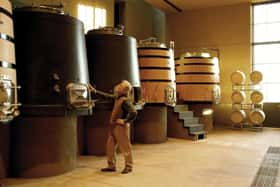 “Problem was, the wine lost a lot of the flavor in stainless that it had gained in concrete,” says Rosenblatt.
“Problem was, the wine lost a lot of the flavor in stainless that it had gained in concrete,” says Rosenblatt.
“A concrete tank is like an old skillet that needs to be seasoned to develop character,” explains Steve Reynolds of Reynolds Family Winery, north of Napa. “Concrete is unique in adding subtle texture and minerality to wine, but it also keeps the fruit alive. Chardonnay and Sauvignon Blanc have been our best fit in the concrete, yielding the best results. We use them to ferment, eventually rack off the lees, and then store the wine in them, as well.”
Reynolds is using two egg-shaped concrete tanks with glycol tubing embedded in the walls for better temperature control. Made to order for Reynolds by Sonoma Cast Stone, the winery’s logo is featured on the front of each tank.
Cameron Frey, vice president of winemaking at Ramey Wine Cellars in Healdsburg, is also using two concrete eggs fabricated in an earthy green color. Last August, the eggs were filled with a single vineyard Sauvignon Blanc made with grapes from the Ritchie Vineyard in the Russian River Valley.
“That’s what we’ve been putting in the eggs pretty much since we first bought them five years ago,” he says. “We played with Chardonnay in them initially, then in 2014 we started a new brand called Sidebar, and realized the eggs would be great for that label’s Sauvignon Blanc.”
Perfect is the word Frey uses to describe the outcome of that wine. “The concrete truly exudes a roundness in the wine that you get with barrel fermentation, but without the oak. Our reason for buying the tanks was mainly curiosity and wondering how white wine would turn out.”
Costs and care
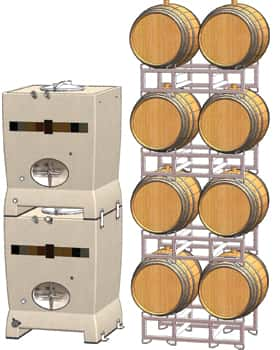 A winery’s bottom line can also play a role in its decision to try concrete. Sonoma Cast Stone’s tanks range from $4,000 to $46,000, depending on the size and shape, plus selected options and shipping.
A winery’s bottom line can also play a role in its decision to try concrete. Sonoma Cast Stone’s tanks range from $4,000 to $46,000, depending on the size and shape, plus selected options and shipping.
“Oak barrels have a lifespan of about six years,” says Frey, and one barrel can cost $1,000 or more. “As far as our cooperage costs go, with concrete we’d likely be money ahead a few years down the road. It seems as if these egg tanks will last indefinitely, if properly taken care of.
Proper care includes proper cleaning. Rosenblatt says winemakers have some control over how much minerality is in the wine by how the tanks are cleaned prior to each refilling. “The concrete is definitely easier to clean than an oak barrel, but not as easy as the stainless steel,” says Frey.
Wineries have different methods of cleaning the tanks, says Rory Williams, assistant winemaker at Frog’s Leap Winery in Rutherford. “But you have to be careful when washing them.”
The winery dipped its toe into concrete in 2015 with the purchase of one 460-gallon egg tank, and since then has added 31 concrete cube-shaped tanks that hold 240 gallons each, the equivalent of four barrels. “It’s mostly Zinfandel in those cubes right now,” he says. “And so far, so good. We’re excited about some of the results from the concrete because we don’t like a lot of oak.”
For its red wines, Frog’s Leap is using some of the cube tanks both as micro-fermenters and as long-term storage. “Our oldest oak barrels are eight and nine years old, and they don’t contribute much to the flavor of the wine after that age, besides just being containers. Concrete is a way for us to buffer our red wine storage, eliminate old oak, and buy higher-quality barrels,” says Williams.
Sauvignon Blanc is fermenting in the egg, he says, to be bottled separately and not blended. “The concrete gives it depth and intensity without us having to add in the usual tricks. We don’t see much stylistic difference between the egg and the cube. I don’t know a lot of the science behind the concrete. The exact interaction going on in those tanks is a mystery to me.”
Heavenly layers
Concrete is also a way for winemakers to experiment by incorporating its use along with oak and stainless.
“Each tank material has its benefits and adds certain layers,” says Reynolds. “The stainless is easy to clean, controls temperature well and keeps pure fruit alive. Wood ferments add texture and complex flavors, and help to soften wine to an early soft maturity level. I like the concrete tanks as a stand-alone, but I love them as a layer. Our whites and most of our reds are fermented in two or three different vessels to gain the complexity and benefits of each. When mixed together, it’s heaven.”
Still, Reynolds says the concrete tanks are not his winery’s “solve all.” Though he enjoys having them, in the end, he says, “All styles of fermenting can be beautiful, and when used together can be outstanding.”
Wineries get a bonus from the tanks: their atypical appearance makes them a curiosity for the uninitiated. “Visitors love the tanks!” says Reynolds. “We have them front and center on our tours of the cellar, and it allows us to show our diversity and talk about some history of winemaking.”
Likewise, Frog’s Leap deliberately points out the concrete tanks to guests. “We are pretty open about our winemaking methods with visitors, and we like to show them off. It’s a good way to interact with folks and explain how they are used,” says Williams.
Infused with terroir
Sonoma Cast Stone specializes in developing innovative concrete formulas for different products, using some proprietary methods. Over the years Rosenblatt has trademarked several, including EarthCrete, a Portland cement-free concrete; MetalCrete, a concrete product with metal surfaces; and NuCrete, a stain-free concrete surface.
The company has a simple recipe for concrete, mixing together Portland cement, sand, aggregate and water. “We usually put in a variety of additives to make the concrete perform in different ways,” he says. “The exception is with our wine and beer tanks. For these we stay with the basic formula to avoid any contamination presented by the additives.”
In general it’s a two-mold process, with a smaller concrete layer placed inside the larger exterior layer. The exteriors are diamond-sanded and hand-polished, and eventually develop a pleasing patina. As many as 24 standard colors are offered for the exterior, adds Rosenblatt, “and none of that touches the wine at all. The inside layer of concrete isn’t sealed because you want the wine to touch the concrete.”
Concrete has great thermal mass, he says. “It’s so thick that it retains temperature very well, and that’s important, because you don’t want to cook the yeast too fast. A concrete tank breathes much like oak, too, and a certain amount of oxygen in wine helps a bit. And in concrete, you also get the taste of the earth.”
Several years ago, Sonoma Cast Stone built a customized tank for Saxum Vineyards near Paso Robles that was infused with soil from one of its vineyards. The winemaker sent Rosenblatt some of the rocks that were rich in limestone. After grinding them down, the fine powder was tested to ensure its structural integrity within the concrete. The wine fermented in the tank received accolades and a 97-point rating in Wine Spectator.
“Talk about terroir!” says Rosenblatt of the Saxum tank. “Concrete adds a creaminess, and mouthfeel is so important. You taste more fruit flavor from concrete than from oak, and the trend right now is to get away from too much oakiness.”
Most of today’s higher-end wines, particularly in Europe, are being fermented in concrete, he says. “Here in the United States I’d guess that about 50 percent of ultrapremium wineries are now using concrete tanks. It’s also a bit of a status symbol. Wineries are proud of them and like to show them off.”
Skilled labor
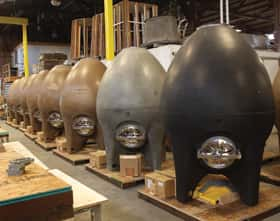 Fabricating the tanks is labor-intensive, and Sonoma Cast Stone produces 100 tanks per year, on average. “By comparison, a stainless company can make between 500 and 600 stainless tanks every year,” says Rosenblatt.
Fabricating the tanks is labor-intensive, and Sonoma Cast Stone produces 100 tanks per year, on average. “By comparison, a stainless company can make between 500 and 600 stainless tanks every year,” says Rosenblatt.
His company has more business than it can handle, he says, but demand for the tanks is increasing. “That’s good when I look at the finances, but bad when I talk to customers! We get backed up when we have multiple orders.”
Finding the right people to make the tanks is also a challenge for Rosenblatt. “Most of our 34 full-time employees have been with us for a decade or more, and they have developed a skill for working with this concrete. That skill is hard to define, but they know just by looking at the concrete how it’s going to react and how it will turn out.
“When we bring in someone new, it can take years for him or her to fully understand the intricacies of the work. We are always looking for smart people who can learn quickly, and we can usually tell within a few days if they are going to pick up the skill.”
The future of concrete
What does the future hold for the concrete tank market? “It’s a good question that I approach with uncertainty,” says Rosenblatt. “If I felt there was unlimited opportunity, we would expand into a larger facility.”
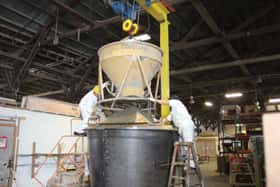 And the odds of other concrete companies transitioning into tank manufacturing are slim, he adds. “It’s not something any concrete company could master easily or profitably.”
And the odds of other concrete companies transitioning into tank manufacturing are slim, he adds. “It’s not something any concrete company could master easily or profitably.”
Reynolds says winemakers love concrete tanks, especially for white varietals, but with limits. “I see concrete tanks staying in play with some growth, but I don’t think they will ever replace wood, particularly with red wines. The texture, flavor and acid from wood creates a soft, mature character and lengthens a wine’s age ability, so I don’t see wood going away, ever.”
Ramey’s concrete eggs, says Frey, continue to create softness and richness that’s not achieved when fermenting and aging wine in stainless steel. “But unless we start making more Sauvignon Blanc, we’ll probably stick with just the two eggs for now. However, we are considering using square concrete tanks for this year’s Pinot Noir and Syrah harvest.”
Yet when it comes to creating world-class Chardonnay and Cabernet Sauvignon, says Frey, “Nothing can replace the magic that happens during elevage in a perfectly coopered oak barrel.”
Author
-

Jean Doppenberg is a lifelong journalist and the author of three guidebooks to Wine Country.
View all posts


